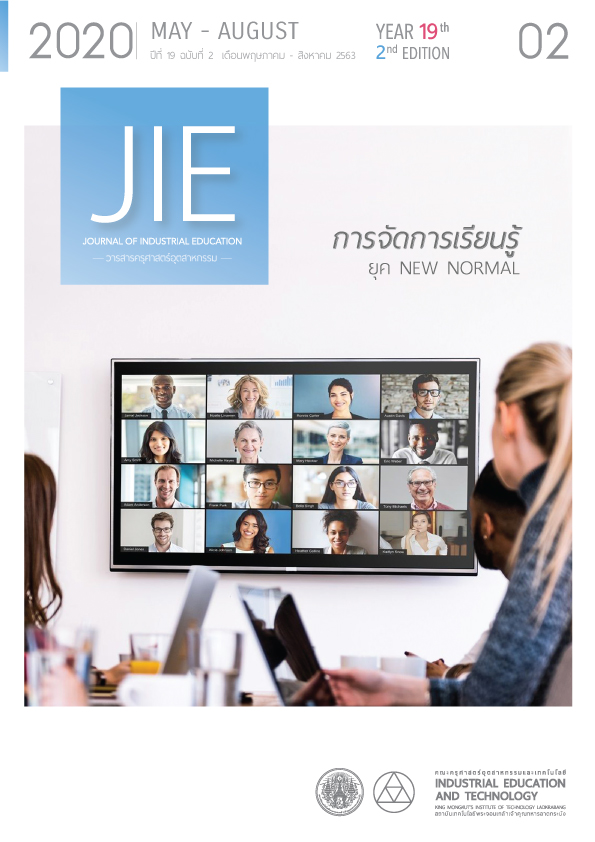ENVIRONMENT IN ARCHITECTURE EDUCATION BUILDING SUPPORTS SELF-DIRECTED LEARNING CASE STUDY: RAJAMANGALA UNIVERSITY OF TECHNOLOGY ISAN
Keywords:
Learning Environment, Architecture Education Building, Self-Directed LearningAbstract
This research is a study of environment in Architecture building supports self-directed learning, Case study at Rajamangala University of Technology Isan. It has objective to study self-directed learning behavior of students and environment in architecture education building which supports self-directed learning. Target group is 196 Bachelor’s Degree students majoring in Architecture, Interior Architecture and Urban Planning Management. This research is a combination of qualitative and quantitative pattern. Research tools are Survey Form, Observation Form and Questionnaire. The data are analyzed on qualitative and quantitative basis. Statistics used are Frequency and Percentage.
The research found 1) Self-directed learning through outside class behavior nature of students. They often gathered in nice weather, semi open air area. They also used mobile phone to search for information from internet. Activities were meeting, group working, doing homework, and relaxing. 2) Environment in Architecture education building should support self-directed learning everywhere and every time, and appropriate for creative learning. Appropriate weather was an important factor that supported happy working of the students. Moreover, green or natural area around education building should be provided to support better concentration of the students, effecting on better working performance. Learning Environment have internet signal support everywhere and every time, have relaxing area, and have common area for co-working can be used flexibly with easy access, informal pattern at 57.10%, partial separated area at 48.00%, cool colors at 82.10%, a combination of furniture arranging at 57.70%, 3-4 seats of group at 40.30%, and have relaxing atmosphere at 62.20%.
References
National Education Act B.E. 2010. Second National Education Act B.E. 2002. [online]. Retrieved from https://person.mwit.ac.th/01-Statutes/NationalEducation.pdf
Thitsana Khammanee. 2009. Teaching Science: Knowledge for effective learning process management. 10th ed. Bangkok: Chulalongkorn University Press.
Pensir Janin. 2009. The Development Guideline to Set Up Self Directed Learning Environment for Rajabhat Kamphaeng Phet University Dormitory’s Students. Research Report Faculty of Management, Kamphaeng Phet Rajabhat University.
Busakorn Romyanond. 2015. Design for Self – Directed Learning Spaces in University Case Study at Thammasat University, Rangsit, Journal of Architectural/Planning Research and Studies (JARS), 12(1), p.1-28.
Marisa Thamma. 2002. Students' satisfaction on the environment of Burapha University Sakaeo Campus. Master of Education Program in Educational Administration, Burapha University.
Chiroj Soorapanth. 2015. Constructing Learning Space. Vajira Medical Journal, 59(4), p.29-34.
Yamane T. 1976. Statistics: An introductory analysis. 2nd ed. New York: Harper and Row.
Bellanca, J and Brandt, R. 2011. 21st Century Skills: Rethinking How Students Learn. Translated by Worapot Wongkitrungruang and Athip Jitrerk. 1st ed. Bangkok: Openworlds.
Washor E. 2003. Innovative Pedagogy and School Facilities. [online]. Retrieved from http://www. archachieve.net/smallschools/Resources/articles/washor.pdf
Manatsawee Srinont. 2018. Theory of Generation and Cognitive Framework. MBU Education Journal : Faculty of Education Mahamakut Buddhist University, 6(1), p.364-373.
Manatsanan Hutasak. 2015. The creation Cognition Teaching and learning process. [online]. Retrieved from http://genzbynpeak.blogspot.com/2017/05/gen-z.html
Downloads
Published
How to Cite
Issue
Section
License
"The opinions and contents including the words in papers are responsibility by the authors."
"ข้อคิดเห็น เนื้อหา รวมทั้งการใช้ภาษาในบทความถือเป็นความรับผิดชอบของผู้เขียน"



